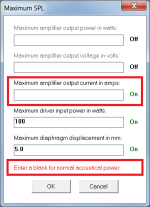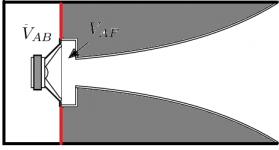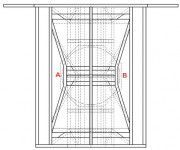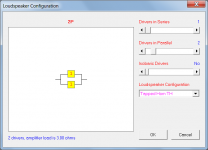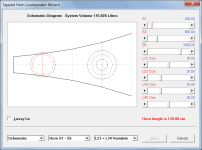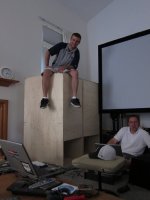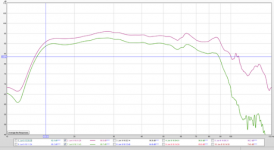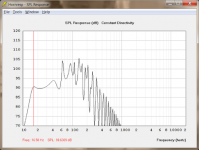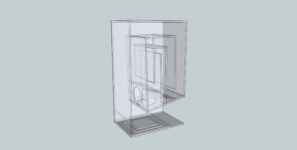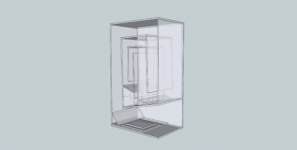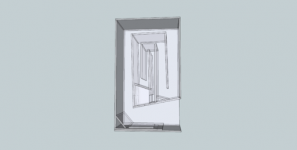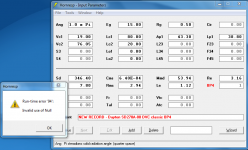Run Time error 13. Type Mismatch
Hi Etocynned,
This seems to be a different error to your previous one. The strange thing is that the problem appears to be confined to your installation only.
Perhaps try saving your existing data files somewhere safe, deleting your existing Hornresp folders and contents, and then downloading and installing a new copy of Hornresp, similar to the process described by Robert in his Post #10920.
https://www.diyaudio.com/forums/subwoofers/119854-hornresp-1092.html#post6271756
If after doing this you still have problems, perhaps send me a copy of your Hornresp.dat file as an email attachment, and I will see if I can find anything wrong in it.
Kind regards,
David
I suspect though that may not stop Hornresp from being flagged as a virus.
I've had AVAST Free for many years and while I was able to retrieve it from the 'sandbox'? the first time, it still flags and prompts me before I can DL it.
GM
so what if in changing the 'Max Driver Power' and accidentally clicking the 'Max Amp Current' to 'ON' with no current setting
Hi GM,
That should just mean that the normal acoustical power is displayed - see attachment. Hopefully you should not have any more problems though, as Hornresp now automatically sets the current to the default value of 4 amps if it finds that no value exists.
Kind regards,
David
Attachments
It is more likely that the action that hornresp takes on first run if installed to an empty folder that is triggering the false positive. In that scenario, hornresp creates several folders and puts files in them. The antivirus heuristic detection algorithms are likely to find these activities suspicious.If connected to the Internet at the time that Hornresp is opened the program automatically checks to see if the latest release is being used. Perhaps this is why your antivirus protection software thinks that Hornresp contains a Trojan.
Will the users who have encountered the false positive confirm whether they are installing to an empty folder or just upgrading a previous version of hornresp?
Hi SamAnytime,
The original download was into a folder in the root directory.
The executable file disappeared but all the rest of the files and folders remained.
I then set Windows security to trust the "Hornresp" site and proceeded to download the program. The executable reappeared in that original folder.
I hope that helps.
Ray
The original download was into a folder in the root directory.
The executable file disappeared but all the rest of the files and folders remained.
I then set Windows security to trust the "Hornresp" site and proceeded to download the program. The executable reappeared in that original folder.
I hope that helps.
Ray
New question: how critical is the shape of the space being used for the closed rear chamber in a horn design? If I can access unused space by cutting out the dividing partition, can I simply consider it as extra space for the rear chamber, or do I need to treat it as separate and model it like a resonator?
Simple example: if I were building this inside a cylindrical pipe, could I knock out the wall in red (leaving only the bracing for mounting the driver) and use the grey shaded region as additional rear chamber space?
Simple example: if I were building this inside a cylindrical pipe, could I knock out the wall in red (leaving only the bracing for mounting the driver) and use the grey shaded region as additional rear chamber space?
Attachments
if I were building this inside a cylindrical pipe, could I knock out the wall in red and use the grey shaded region as additional rear chamber space?
Yes, provided that the wavelengths are reasonably long compared to the dimensions of the chamber, and / or the enclosing panels are angled such that internal reflections do not become an issue.
Paul Klipsch did exactly this in his Klipschorn bass corner horn design, where he placed suitably-sized openings at the positions marked A and B in the attachment, so that the previously unused volumes on either side of the front section of the horn were added to the rear volume.
To quote from his 1942 "Improved Low Frequency Horn" paper:
"One minor change consisted of increasing the volume of the air chamber behind the cone by opening up the otherwise dead air spaces in the front of the cabinet lying on either side of the first horn section. This added approximately 600 cubic inches to the back air chamber. These openings must be sufficiently large so that they do not introduce an appreciable inertance between the two side air chambers and the back air chamber. A total area of opening of approximately 15 square inches is sufficient."
Attachments
I installed on my other Laptop today.Hi SamAnytime,
The original download was into a folder in the root directory.
The executable file disappeared but all the rest of the files and folders remained.
I then set Windows security to trust the "Hornresp" site and proceeded to download the program. The executable reappeared in that original folder.
I hope that helps.
Ray
This time W10, asked "do you trust this program". I did, and had no problems!
I have recently done some W10 updates on this Laptop.
Perhaps they've fixed the killer Defender?!
is their a way to account for two drivers in a tapped horn
Multiple drivers can be specified using the Loudspeaker Configuration Tool.
Attachments
So cool the software author is answering my question! Thank you so much. I guess my confusion lies with the location of the drivers. In the DTS 10, the drivers are not side by side seeing the same acoustic resistance, rather 1 driver is located in the L12 area and the 2nd driver is in the L23 area. Does simple specifying 2 drivers in parallel or series handle that? Of course, what do I model if I use a stereo amp to have each channel individually power a driver? Is that series or parallel. I’m guessing series.
Other than this enormous thread, are there some simple tutorials about using Hornresp and specific rules on how to use the software to maximize certain characteristics say to lower frequency, maximize spl, decrease displacement, optimize box size or is just endless tweaking of the variable until I’m happy?
Again, thanks for your help.
Other than this enormous thread, are there some simple tutorials about using Hornresp and specific rules on how to use the software to maximize certain characteristics say to lower frequency, maximize spl, decrease displacement, optimize box size or is just endless tweaking of the variable until I’m happy?
Again, thanks for your help.
Does simple specifying 2 drivers in parallel or series handle that?
Multiple drivers are modelled in Hornresp as a single composite driver. The required composite driver parameter values are calculated automatically by the program - the parameter values specified by the user should be for a single driver. In a TH1 or 3 segment TH horn one side of the composite driver is positioned at S2 and the other side at S3. In a 4 segment TH horn one side of the composite driver is positioned at S2 and the other side at S4, as shown in the attachment. At the low frequencies at which tapped horns normally operate, having the drivers co-located in the simulation model makes little difference to the overall accuracy of the results.
what do I model if I use a stereo amp to have each channel individually power a driver? Is that series or parallel.
Hornresp assumes that multiple drivers are powered by a single amplifier. If the drivers are connected in series the amplifier will be nominally loaded by 2 * Re. If the drivers are connected in parallel the amplifier will be nominally loaded by 0.5 * Re. I would be inclined to use a parallel connection, but the final decision has to be yours.
are there some simple tutorials about using Hornresp and specific rules on how to use the software
There are some relatively old tutorials available (Google 'Hornresp tutorial') but they don't address many of the newer features. The Loudspeaker Wizard can be used to help with the design optimisation process.
Attachments
like the Danley DTS-10 or superspud? Any threads on this with examples?
I like to think this performs like the single driver DTS20...
Collaborative Tapped Horn Project
At 400+ pages its a long read! My build of this design is somewhat condensed
Alpine 12" tapped horn home theatre subwoofer build
Here is a design by Lilmike of a dual 12" design somewhat similar to the DTS10...
Drawings
Its a shame so many of the images in that thread are broken - a web search turns up some remnants but not the HR input screen.
Attachments
Last edited:
It’s often suggested that complex shapes and what not are a job for akabak or other ways. I don’t think it’s observed that it’s not so much those shapes that can be avoided if you understand the ability to pick and choose which ones to tell HR that are needed for input to get a result. All of which can be avoided in various ways and the real power in the HR sim is the mechanisms by which it is processing complex flare and size changes in the great span of them if used.
Every section of HR is proving the same resources in calculations but rearranging the places it might be easier to do so for a person designing with a certain thought in mind.
If you’ve run out of a specific thing to incorporate it’s quite oostibne to still sum pieces of it in seperate but weather or not those can be used to create a measure of justification to build it is a thing. But that thing is quickly showing promise in expiriments to measure results and compare...
Is the maths for things that could be used in conjunction with the program to do that available or in AES papers by persons that might? There’s lots of math to grab here and there and it all seems to work(since it’s math, not opinions) but people seem to forget how to use this program with any intent other that being good at sliders and often aren’t aware they’re forgetting why.
If thee was a basis for the things a great many people are very fond of HR for allowing them to do, but really only know it as a slider or a symbol, thus all fades into fog as the ones who knew can’t reach the minds of those they can only lead to the water. Nobody is drinking. And everyone has a huge glass to use in the HR sim. I really appreciate this huge glass and the people willing to fill it. It’s done me very well. But I’m still realizing much of what I’m barely getting ahold of is not going to continue as electronic stuff or easier things might be a DIY future instead of ? I don’t see much effort to even learn HR in people who clearly miss out on a lot of things because where to learn vs the effort to do it is not a concept in a society where Knowing is a smart phone. Not actually knowing at all... ?
Every section of HR is proving the same resources in calculations but rearranging the places it might be easier to do so for a person designing with a certain thought in mind.
If you’ve run out of a specific thing to incorporate it’s quite oostibne to still sum pieces of it in seperate but weather or not those can be used to create a measure of justification to build it is a thing. But that thing is quickly showing promise in expiriments to measure results and compare...
Is the maths for things that could be used in conjunction with the program to do that available or in AES papers by persons that might? There’s lots of math to grab here and there and it all seems to work(since it’s math, not opinions) but people seem to forget how to use this program with any intent other that being good at sliders and often aren’t aware they’re forgetting why.
If thee was a basis for the things a great many people are very fond of HR for allowing them to do, but really only know it as a slider or a symbol, thus all fades into fog as the ones who knew can’t reach the minds of those they can only lead to the water. Nobody is drinking. And everyone has a huge glass to use in the HR sim. I really appreciate this huge glass and the people willing to fill it. It’s done me very well. But I’m still realizing much of what I’m barely getting ahold of is not going to continue as electronic stuff or easier things might be a DIY future instead of ? I don’t see much effort to even learn HR in people who clearly miss out on a lot of things because where to learn vs the effort to do it is not a concept in a society where Knowing is a smart phone. Not actually knowing at all... ?
New to me runtime error 94:
Hi GM,
Thanks for the feedback. The error appears to be the same as the one reported by Etocynned in Post #10908. It is interesting that the record number text box is shown empty on your screenprint - not sure what that means.
In the post just above yours Etocynned indicates that the error occurs if the computer goes into sleep mode when Hornresp is open - the next save causes the error. Is this your experience also?
There must be a reason for the error but frustratingly, unless I can generate it myself, there is not much I can do about fixing it, unfortunately.
Kind regards,
David
Greets!
Huh! Didn't even notice it missing.
No, I generally keep HR open until a proper computer reboot and put it in sleep mode many times a day with nary an error on waking it up. I had just finished/saved a record, clicked 'add' and got the error. When I rebooted, looked in 'find' to get the last record [original] to try copying again only to find this 'blank' one as the last one, so clicked on it and it loaded fine, then changed it somewhat and saved it with no problems plus done some new records with it, so even more of a head scratcher to me, what with a missing record # shown when HR closed itself.
GM
Huh! Didn't even notice it missing.
No, I generally keep HR open until a proper computer reboot and put it in sleep mode many times a day with nary an error on waking it up. I had just finished/saved a record, clicked 'add' and got the error. When I rebooted, looked in 'find' to get the last record [original] to try copying again only to find this 'blank' one as the last one, so clicked on it and it loaded fine, then changed it somewhat and saved it with no problems plus done some new records with it, so even more of a head scratcher to me, what with a missing record # shown when HR closed itself.
GM
- Home
- Loudspeakers
- Subwoofers
- Hornresp
